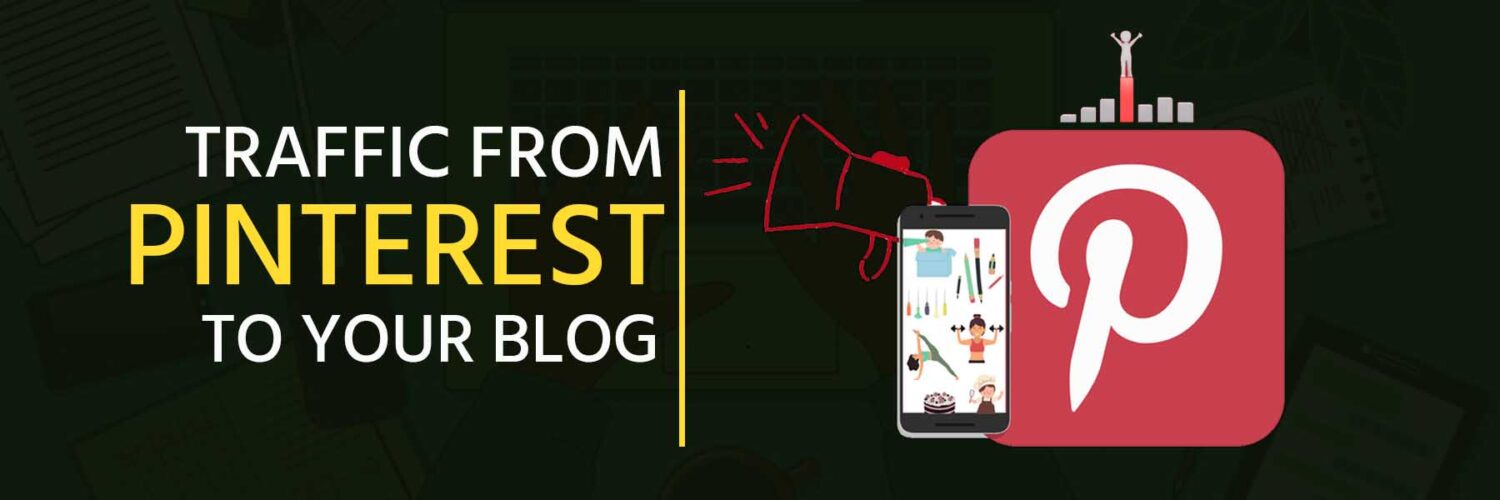To use Pinterest for blogging, create a business account and design visually appealing pins. Optimize your pins with keywords and link them to your blog.
Pinterest is a powerful tool for bloggers seeking to drive traffic to their websites. With over 400 million active users, it’s a visual search engine that can amplify your blog’s reach. To get started, switch to a Pinterest business account for analytics and promotional tools.
Create eye-catching pins that resonate with your target audience. Use compelling images, concise text, and relevant keywords to boost visibility. Link each pin directly to your blog posts to guide users to your content. Consistent pinning and engaging with your audience are crucial for long-term success. Leverage Pinterest’s potential to grow your blog efficiently.
Setting Up Your Account
Pinterest is a powerful tool for bloggers. It can drive traffic to your site and increase visibility. Setting up your account correctly is the first step to success. This guide will help you set up your Pinterest account for blogging.
Creating A Business Account
To start, you need a business account. A business account has many benefits. It gives you access to Pinterest Analytics. You can also use Pinterest Ads. Here is how to create a business account:
- Go to Pinterest.com
- Click on “Sign up”
- Select “Create a business account”
- Fill in your details
- Click on “Create Account”
Once your account is set up, you can start customizing it. Make sure to use a professional email address. This helps in building trust with your audience. Also, choose a username that reflects your blog name or niche. This makes it easy for users to find you.
Optimizing Your Profile
Your profile is the first thing people see. It should be attractive and informative. Follow these steps to optimize your profile:
- Upload a clear profile picture
- Write a compelling bio
- Include keywords in your bio
- Add your blog URL
- Enable rich pins
Your profile picture should be a high-quality image. A logo works best for branding. Your bio should tell people who you are and what you do. Use keywords in your bio to improve search visibility. Adding your blog URL is crucial. It directs traffic from Pinterest to your blog. Rich pins provide more information about your pins. This makes them more useful and attractive.
Creating Eye-catching Pins
Pinterest is a great tool for bloggers. It helps drive traffic to your blog. Creating eye-catching pins is key. Attractive pins can grab attention. They can also lead to more clicks and shares.
Design Tips
Creating beautiful pins is important. Use bright colors to make your pins stand out. High-quality images are a must. Blurry images will not get attention.
Text on pins should be easy to read. Use bold fonts for headlines. Choose colors that contrast well. This makes the text pop. Keep your design simple. Too many elements can be confusing.
Here are some design tips to follow:
- Use vertical images. They perform better on Pinterest.
- Include your blog name or logo on the pin.
- Add a call to action. This encourages people to click.
- Using Keywords Effectively
Keywords help your pins get discovered. Research popular keywords in your niche. Use these keywords in your pin titles and descriptions.
Place the most important keywords at the beginning. This helps with search results. Use natural language. Avoid keyword stuffing. It can make your pin look spammy.
| Good Keyword | Bad Keyword |
|---|---|
| Healthy recipes | Healthy recipes easy fast cheap |
| Travel tips | Travel tips budget save money |
Hashtags can also be useful. Add a few relevant hashtags to your pin description. This can help your pins reach a larger audience.
Building A Content Strategy
Pinterest is a powerful tool for bloggers. It drives traffic and increases your audience. Building a strong content strategy is key. This guide will help you use Pinterest effectively. Learn how to identify your niche and schedule your pins. Get ready to boost your blog’s reach and engagement.
Identifying Your Niche
A niche helps you focus your content. It attracts the right audience. Start by identifying your interests and expertise. What topics do you enjoy? What are you good at? Your niche should be something you are passionate about. This makes it easier to create content.
Here are some steps to identify your niche:
- List your hobbies and interests
- Research popular topics on Pinterest
- Check out your competition
- Find gaps in the market
Once you have a list, narrow it down. Focus on a specific area. For example, instead of general cooking, choose vegan baking. This helps you stand out. Create boards and pins that reflect your niche. Use keywords related to your niche. This helps people find your content. Be consistent with your niche. This builds your brand and audience.
Scheduling Your Pins
Consistency is key on Pinterest. Scheduling your pins helps maintain a steady flow of content. Use tools like Tailwind or Buffer. These tools allow you to plan and schedule your pins. You can set times and dates for your pins to go live.
Here are some tips for scheduling your pins:
- Pin at least 5 times a day
- Spread your pins throughout the day
- Pin a mix of your content and others
- Schedule pins for peak times
Peak times are usually in the evening. Weekends are also good for pinning. Check your analytics to find the best times for your audience. Create a content calendar. Plan your pins for the week or month. This helps you stay organized and consistent. Regular pinning keeps your audience engaged. It also helps improve your reach and visibility.
Engaging With The Community
Bloggers often overlook Pinterest, but it is a powerful tool. Pinterest helps drive traffic to blogs. Engaging with the community is crucial. This guide will explore how to use Pinterest for blogging and engage with the community effectively.
Following Relevant Boards
Following relevant boards on Pinterest is important. It helps you stay updated with trends in your niche. Find boards that match your blog’s theme. This will keep your feed full of useful content.
Here are steps to follow relevant boards:
- Search for keywords related to your blog.
- Look for boards with many followers and pins.
- Follow boards that have high-quality pins.
Following relevant boards helps you find inspiration. You can discover content ideas and learn from other bloggers. Make sure to engage with the pins you like. This shows the board owners you are active and interested.
To summarize, finding and following the right boards is key. It keeps your Pinterest feed relevant. It also helps in building a network with other bloggers.
Joining Group Boards
Group boards are collaborative boards where multiple users can pin. Joining group boards can increase your blog’s visibility. More people will see your pins, driving traffic to your blog.
Here’s how to join group boards:
- Search for group boards in your niche.
- Check the board’s rules and requirements.
- Send a request to join or contact the board owner.
Once you join a group board, start pinning your content. Follow the board’s rules to avoid getting removed. Group boards are great for getting more eyes on your pins. They help you reach a wider audience.
Joining and being active on group boards boosts your blog’s traffic. It also helps in building relationships with other bloggers in your niche.
Analyzing Your Performance
Pinterest is a powerful tool for bloggers. It helps drive traffic and engage with a wider audience. By understanding how to use Pinterest Analytics, you can analyze your performance and improve your strategy. Tracking traffic to your blog is crucial. It helps you see what works and what doesn’t. Let’s explore how to use Pinterest for blogging and analyze your performance.
Using Pinterest Analytics
Pinterest Analytics is essential. It shows how your pins and boards are performing. This tool offers insights into what content resonates with your audience. To get started, access Pinterest Analytics from your business account. You can see various metrics such as impressions, clicks, and saves. These metrics help you understand user engagement.
There are key areas to focus on in Pinterest Analytics:
- Impressions: Number of times your pins were seen.
- Clicks: Number of times users clicked on your pins.
- Saves: Number of times users saved your pins to their boards.
Analyzing these metrics helps you identify popular content. You can create more of what your audience loves. Another useful feature is the Audience Insights. This shows you data about your followers. You can see their interests and demographics. Use this information to tailor your content. Creating pins that appeal to your audience increases engagement. Regularly check Pinterest Analytics to stay updated on your performance.
Tracking Traffic To Your Blog
Tracking traffic from Pinterest to your blog is important. Google Analytics is a great tool for this. Link your blog to Google Analytics. This allows you to see where your traffic comes from. In the Google Analytics dashboard, go to Acquisition > Social > Network Referrals. Here, you can see the traffic from Pinterest.
Another way to track traffic is by using UTM parameters. These are tags you add to your URLs. They help you track the source of your traffic. Use a tool like Google’s Campaign URL Builder to create these tags. Add them to the links in your pins. This way, you can see which pins drive the most traffic.
There are a few key points to keep in mind:
- Create engaging pins with clear descriptions.
- Include a call to action in your pin descriptions.
- Optimize your blog for mobile devices.
By tracking traffic, you can see what works best. You can adjust your strategy based on this data. Keep an eye on your analytics and make necessary changes. This helps you grow your blog using Pinterest effectively.
Staying Updated
Blogging and social media go hand in hand. Pinterest is a powerful tool for bloggers. It helps drive traffic and reach a larger audience. Staying updated with Pinterest trends can boost your blog’s visibility. Let’s explore how to use Pinterest effectively and stay ahead of the curve.
Latest Trends On Pinterest
Pinterest evolves constantly. Keeping up with latest trends can be challenging. Here are some trends to watch:
Idea Pins: These are like Stories on Instagram. They are engaging and interactive.
Video Content: Videos are gaining popularity. They get more views and engagement.
Seasonal Content: Create pins for holidays and seasons. They get more attention during those times.
Using keywords is crucial. Pinterest acts like a search engine. Users search for ideas and inspiration. Optimize your pins with relevant keywords. This helps your content appear in search results.
High-quality images make a difference. Pins with clear, bright images get more clicks. Use vertical images for better visibility.
Adapting Your Strategy
Analyze your performance regularly. Pinterest Analytics can help. Check which pins get the most engagement. Focus on creating similar content.
Schedule your pins for consistent posting. Tools like Tailwind can assist. Consistent pinning keeps your content fresh and visible.
Engage with your audience. Respond to comments and messages. This builds a community around your blog.
Collaborate with other pinners. Join group boards in your niche. This expands your reach and attracts new followers.
Test different formats. Try static images, videos, and Idea Pins. See what resonates best with your audience. Adapt your strategy based on the results.
Conclusion
Mastering Pinterest can significantly boost your blog’s visibility and engagement. Pin consistently, use keywords, and create eye-catching graphics. Engage with your audience and join group boards. Pinterest can drive traffic and enhance your blogging success. Start implementing these strategies today and watch your blog flourish.




Add comment